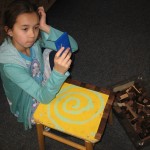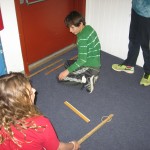 We began our area and perimeter unit by finding the area of rectangles. For elementary children, rectangles/squares allow students to see how multiplication can be applied to finding the solution. We always begin at the beginning and for area that means covering various objects with square units (we used square inch tiles). Before finding the area they were to make an estimate. Estimation is a valuable skill; it improves learning and is used in everyday life. Most students enjoy making their best guess and then seeing how close or how far away their estimate was. Students had different levels of understanding: some completely covered each object and then used various methods to count the tiles. Most had enough previous knowledge of rectangular area to use some version of length-
We began our area and perimeter unit by finding the area of rectangles. For elementary children, rectangles/squares allow students to see how multiplication can be applied to finding the solution. We always begin at the beginning and for area that means covering various objects with square units (we used square inch tiles). Before finding the area they were to make an estimate. Estimation is a valuable skill; it improves learning and is used in everyday life. Most students enjoy making their best guess and then seeing how close or how far away their estimate was. Students had different levels of understanding: some completely covered each object and then used various methods to count the tiles. Most had enough previous knowledge of rectangular area to use some version of length- times-width. Some fully covered the object but used only the length and width. Others laid down tiles on only the length and width, and still others were able to use a ruler to measure the 2 necessary dimensions and multiply them. All of these methods are developmentally appropriate and they all work. Once students correctly found the area of these small objects, they were challenged to find the area of a room (the math room, the tutoring room, or the gym). This naturally meant that covering the floor with square inch tiles was not an option. This forced them to use a more efficient method and to transfer what they had tried and learned with the small rectangular things to a much larger footprint. Working in small groups, students had to figure out how to use rulers, yard sticks and calculators to find the area.
times-width. Some fully covered the object but used only the length and width. Others laid down tiles on only the length and width, and still others were able to use a ruler to measure the 2 necessary dimensions and multiply them. All of these methods are developmentally appropriate and they all work. Once students correctly found the area of these small objects, they were challenged to find the area of a room (the math room, the tutoring room, or the gym). This naturally meant that covering the floor with square inch tiles was not an option. This forced them to use a more efficient method and to transfer what they had tried and learned with the small rectangular things to a much larger footprint. Working in small groups, students had to figure out how to use rulers, yard sticks and calculators to find the area.
 At Bixby, students are allowed the opportunities to discover these ideas. As children develop formulas, they gain conceptual understanding of the ideas and relationships involved. And students who understand where formulas come from do not see them as mysterious, tend to remember them, and are reinforced in the idea that math makes sense. Rote use of formulas offers none of these advantages. It is a common joy of mine to see students make these connections (“Oh, I can just multiply this side by that side! That is so much easier!”). I can give them the language (you mean multiply the length-times-the width), but the discovery is all theirs.
At Bixby, students are allowed the opportunities to discover these ideas. As children develop formulas, they gain conceptual understanding of the ideas and relationships involved. And students who understand where formulas come from do not see them as mysterious, tend to remember them, and are reinforced in the idea that math makes sense. Rote use of formulas offers none of these advantages. It is a common joy of mine to see students make these connections (“Oh, I can just multiply this side by that side! That is so much easier!”). I can give them the language (you mean multiply the length-times-the width), but the discovery is all theirs.



